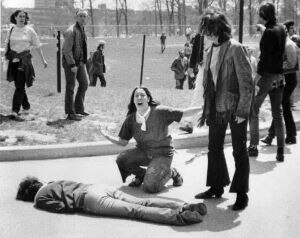| Kent State shootings | |
|---|---|
 John Filo's Pulitzer Prize–winning photograph of Mary Ann Vecchio kneeling over the dead body of Jeffrey Miller minutes after the unarmed student was fatally shot by an Ohio National Guardsman | |
| Location | Kent State University, Kent, Ohio, United States |
| Date | May 4, 1970 12:24 p.m. (Eastern Daylight Time: UTC−4) |
Attack type | Mass shooting |
| Deaths | 4 |
| Injured | 9 |
| Victims | Kent State University students |
| Perpetrators | Companies A and C, 1-145th Infantry and Troop G, 2-107th Armored Cavalry of the Ohio National Guard |
| Accused |
|
| Verdict | Not guilty |
| Charges | Deprivation of rights under color of law |
| Judge | Frank J. Battisti |
May 4, 1970, Kent State Shootings Site | |
| Location | 0.5 mi. SE of the intersection of E. Main St. and S. Lincoln St., Kent, Ohio |
| Coordinates | 41°09′00″N 81°20′36″W / 41.1501°N 81.3433°W |
| Area | 17.24 acres (6.98 ha)[2] |
| NRHP reference No. | 10000046[1] |
| Significant dates | |
| Added to NRHP | February 23, 2010[1] |
| Designated NHL | December 23, 2016 |
The Kent State shootings (also known as the Kent State massacre or May 4 massacre[3][4][5]) were the killing of four and wounding of nine unarmed college students by the Ohio National Guard on the Kent State University campus. The shootings took place on May 4, 1970, during a rally opposing the expanding involvement of the Vietnam War into Cambodia by United States military forces as well as protesting the National Guard presence on campus and the draft. Twenty-eight National Guard soldiers fired about 67 rounds over 13 seconds, killing four students and wounding nine others, one of whom suffered permanent paralysis. Students Allison Krause, 19, Jeffrey Miller, 20, and Sandra Scheuer, 20, died on the scene, while William Schroeder, 19, was pronounced dead at Robinson Memorial Hospital in nearby Ravenna shortly afterward.[6][7]
Krause and Miller were among the more than 300 students who gathered to protest the expansion of the Cambodian campaign, which President Richard Nixon had announced in an April 30 television address. Scheuer and Schroeder were in the crowd of several hundred others who had been observing the proceedings more than 300 feet (91 m) from the firing line; like most observers, they watched the protest during a break between their classes.[8][9]
The shootings triggered immediate and massive outrage on campuses around the country. It increased participation in the student strike that began on May 1. Ultimately, more than 4 million students participated in organized walk-outs at hundreds of universities, colleges, and high schools. The shootings and the strike affected public opinion at an already socially contentious time over the role of the United States in the Vietnam War.[10]
Eight of the shooters were charged with depriving the students of their civil rights, but were acquitted in a bench trial. The trial judge stated, "It is vital that state and National Guard officials not regard this decision as authorizing or approving the use of force against demonstrators, whatever the occasion of the issue involved. Such use of force is, and was, deplorable."[11]
- ^ a b "Announcements and actions on properties for the National Register of Historic Places for March 5, 2010". Weekly Listings. National Park Service. March 5, 2010. Archived from the original on August 28, 2013. Retrieved March 5, 2010.
- ^ Cite error: The named reference
nrhpregwas invoked but never defined (see the help page). - ^ "These would be the first of many probes into what soon became known as the Kent State Massacre. Like the Boston Massacre almost exactly two hundred years before (March 5, 1770), which it resembled, it was called a massacre not for the number of its victims, but for the wanton manner in which they were shot down." Philip Caputo (May 4, 2005). "The Kent State Shootings, 35 Years Later". NPR. Archived from the original on May 16, 2020. Retrieved November 9, 2007.
- ^ Rep. Tim Ryan (May 4, 2007). "Congressman Tim Ryan Gives Speech at 37th Commemoration of Kent State Massacre". Congressional website of Rep. Tim Ryan (D-Ohio). Archived from the original on July 25, 2007. Retrieved November 9, 2007.
- ^ John Lang (May 4, 2000). "The day the Vietnam War came home". Scripps Howard News service. Archived from the original on February 11, 2010. Retrieved November 9, 2007.
- ^ Shots Still Reverberate For Survivors Of Kent State Archived July 16, 2018, at the Wayback Machine 'Dean Kahler, who was paralyzed during the shootings, went on to become a high school teacher and covered the events of May 4 in his classes' NPR News, May 3, 2010. Retrieved January 20, 2014.
- ^ Dean Kahler: Visitors' Center helps him move past May 4, 1970 Archived October 24, 2017, at the Wayback Machine 'Dean Kahler, among the most severely wounded of the 13 Kent State students shot by the National Guard on May 4, 1970, tours the new May 4th Visitors' Center being dedicated this weekend' WKSU, May 3, 2013. Retrieved January 20, 2014.
- ^ "Sandy Scheuer". May 4, 1970. Archived from the original on May 18, 2003. Retrieved May 12, 2013.
- ^ Jerry M. Lewis; Thomas R. Hensley (Summer 1998). "The May 4 Shootings At Kent State University: The Search For Historical Accuracy". Ohio Council for the Social Studies Review. 34 (1): 9–21. ISSN 1050-2130. OCLC 21431375. Archived from the original (Reprint) on May 9, 2008. Retrieved April 16, 2007.
- ^ Cite error: The named reference
highlightwas invoked but never defined (see the help page). - ^ Salpukas, Agis (November 9, 1974). "Judge Acquits Guardsmen In Slayings at Kent State". The New York Times. ISSN 0362-4331. Retrieved March 13, 2024.

